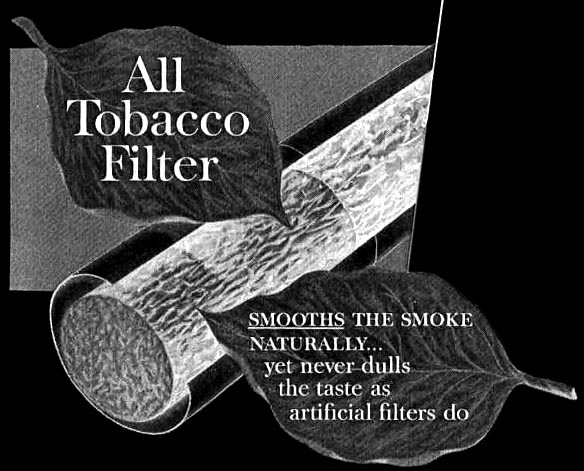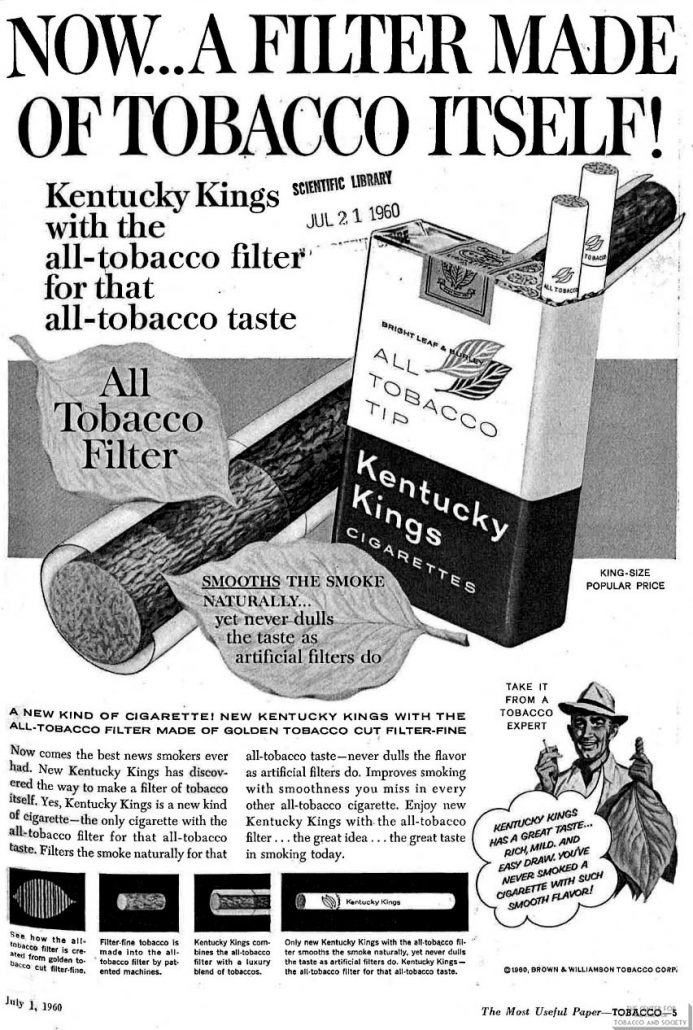As concerns about the health effects of cigarettes mounted in the mid 20th century, Brown and Williamson introduced a novel way to combat fears about tobacco: more tobacco.
Now a Filter Made of Tobacco Itself
Advertisement for Brown and Williamson Tobacco Company’s Kentucky Kings cigarettes
Tobacco (Industry trade publication)
July 4, 1960
“This is one of the all-time bizarre ads.”
Alan Blum, MD, Director of the Center for the Study of Tobacco and Society
In the pantheon of ideas so crazy they just have to work, we can assume the All Tobacco Filter in Kentucky Kings cigarette, introduced in 1969, is one of the crazy ideas that never worked. Touting its golden tobacco cut “filter fine,” Brown and Williamson Tobacco Company promised that this cigarette would filter smoke naturally for an all-tobacco taste.
Cigarette filters date back to 1925 when a Hungarian inventor, M. Boris Aivarz, applied for a patent for the design of a filter tip made of crepe paper, cellulose–and a machine to manufacture them.¹ The proliferation of cigarettes with filters gradually increased in the 1930s and 1940s, then soared in the 1950s after the publication of the first scientific studies showing that cigarette smoking caused lung cancer. Filters were promoted as having a variety of materials such as charcoal, cellulose acetate, perforated paper, and polypropylene glycol.² The misleading terms “low tar,” “mild,” and “light” would be added to advertising for filtered cigarettes in the 1960s. Deceptive testing practices provided results that demonstrated the effectiveness of filters, but perforated or so-called ventilated filters “smoked” by machines skewed the results in favor of cigarette manufacturers. In actual smoking, the smoker ‘s lips cover up the perforations. Cigarette butts, which contain the filter, comprise the vast majority of tobacco waste and continue to pose a toxic hazard to the environment.
While Brown and Williamson’s all-tobacco filter might seem absurd, consider that Kent’s Micronite Filter was developed using asbestos, a powerful carcinogen.³ Perhaps the All Tobacco Filter wasn’t that bad of an idea… still a bad idea, but not that bad.
¹ The History of Filters. www.tobaccoasia.com. https://web.archive.org/web/20030824115139/http://www.tobaccoasia.com/news.asp?id=534. Published August 24, 2003. Accessed March 27, 2019. Accessed via web.archive.org
² The Filter Fraud Debunking the Myth of “Safer” as a Key New Strategy of Tobacco Control. https://csts.ua.edu/files/2019/03/2018-Filter-Fraud-Poster-AB-Novotny.pdf. Published June 12, 2018. Alan Blum MD, Thomas E. Novotny MD MPH.
³ “Kent Micronite Filter Cigarette Advertisement and Cigarettes 1955”. https://csts.ua.edu/collections/best-of-collection/.



